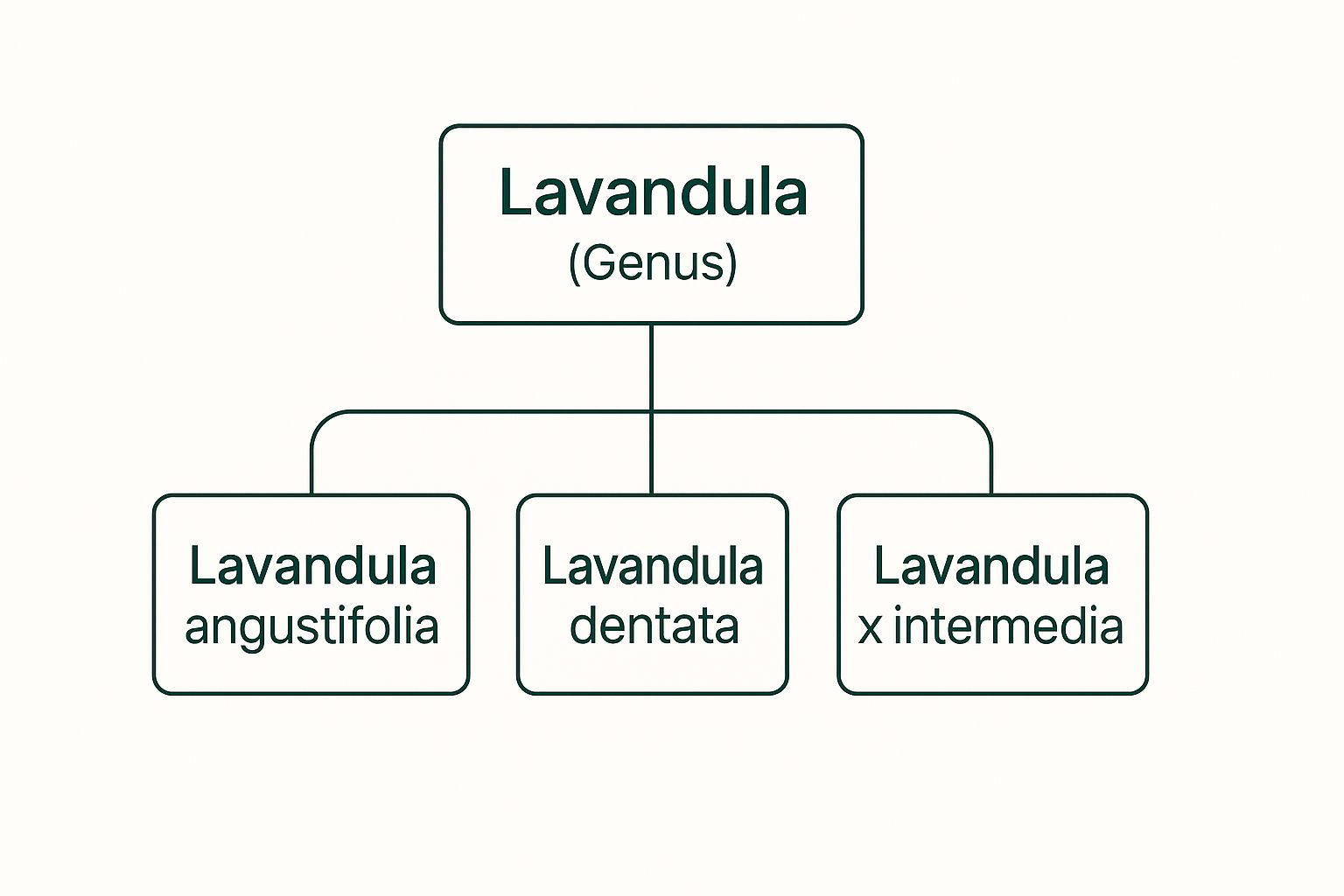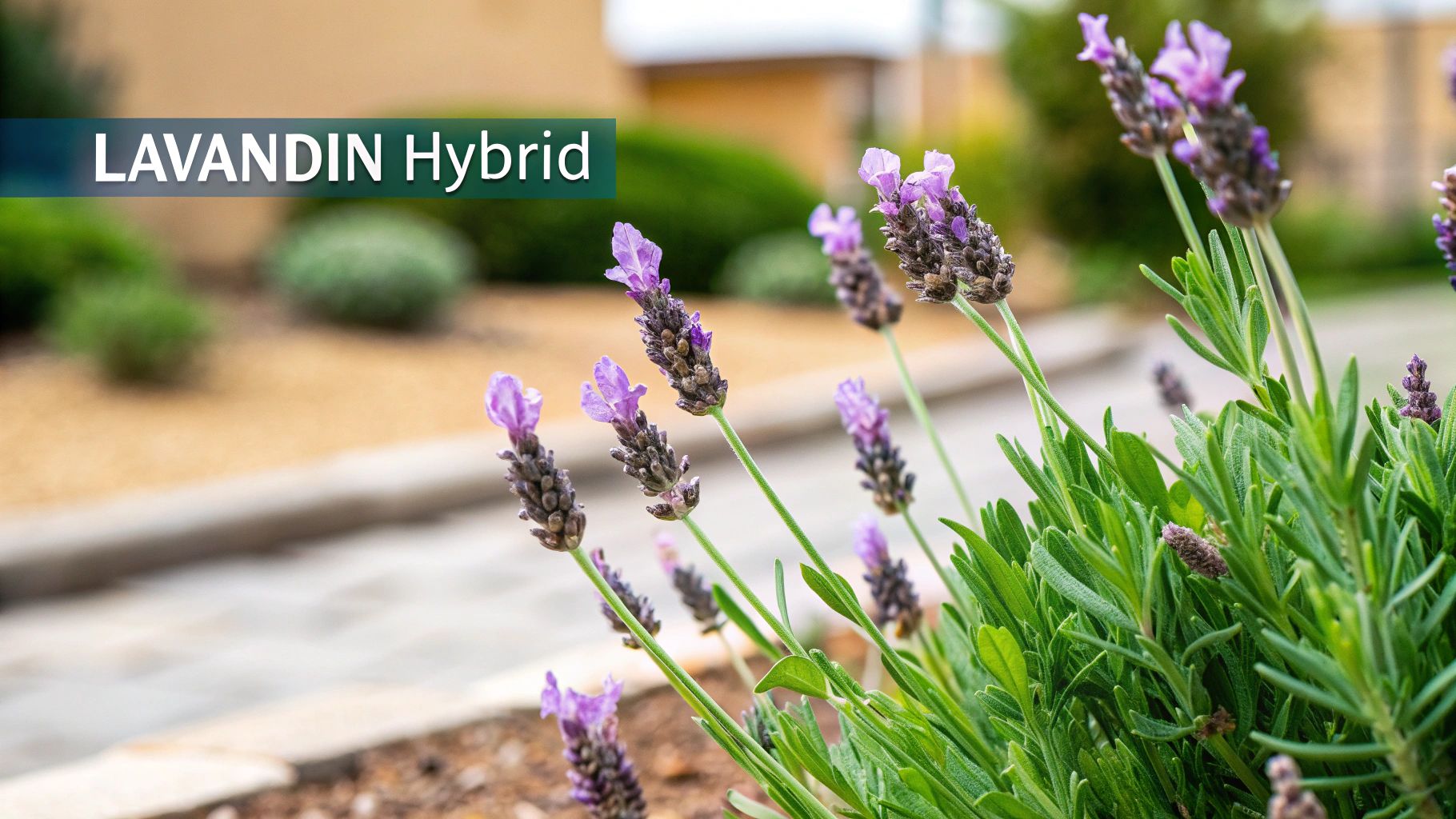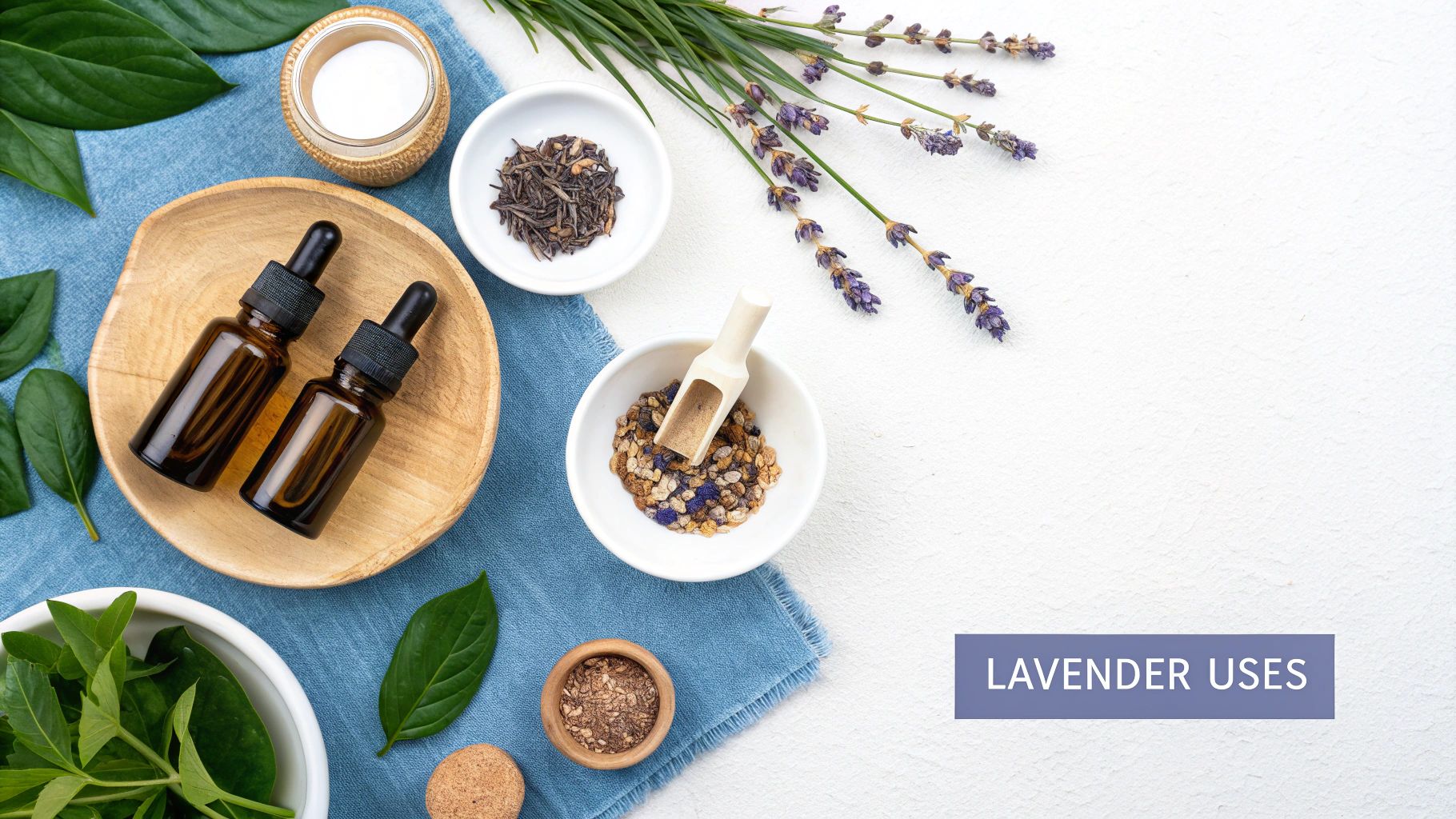
When people ask how many types of lavender there are, the answer isn't as simple as one number. It's a two-part story. First, you have the main, naturally occurring types—there are 47 recognized species of lavender.
From those core species, growers and botanists have bred an incredible range of over 450 different varieties. Each one has its own personality, from its specific shade of purple (or pink, or white!) to its unique scent and growth habit.
From Wild Species to Garden Varieties
Think of it like this: the lavender species are the main branches of a sprawling family tree. The hundreds of varieties are all the individual family members, each with their own quirks and looks, even though they share a common ancestry. This is why there’s a perfect lavender for almost any garden or purpose you can imagine.
Scientifically, all lavender belongs to the genus Lavandula, a member of the mint family. These plants originally hail from the Old World, flourishing in the wild from the sun-drenched Mediterranean coast to parts of Africa and India. Over centuries, they've adapted to different climates, which explains why the 47 species can be so different from one another. You can dive deeper into their global origins and history if you're curious.
:max_bytes(150000):strip_icc():format(webp)/growing-lavender-1402779-01-de04652286954641838634289ddc6b75.jpg)
Lavender's amazing diversity isn't just an accident. Each variety was carefully selected and bred for a reason—whether for extra-potent essential oils, a delicate flavor in the kitchen, or simply for its stunning looks in a flower bed.
So, what's the real difference between a species and a variety? It’s a common point of confusion, but it’s pretty straightforward.
Here’s a quick table to break it down.
Lavender at a Glance: Species vs. Varieties
| Category | Approximate Number | Description |
|---|---|---|
| Species | 47 | The original, naturally occurring types of lavender found in the wild. Think of these as the "parents." |
| Varieties | Over 450 | Bred by humans from the original species for specific traits like color, size, or oil quality. These are the "children." |
Basically, the species are the wild ancestors, and the varieties (also called cultivars) are the cultivated descendants we plant in our gardens today.
- A species is a distinct, wild type, like Lavandula angustifolia (commonly known as English Lavender).
- A variety is a specific cultivated version of a species, like 'Hidcote' or 'Munstead', which are two of the most popular and beloved types of English Lavender.
Decoding the 4 Main Groups of Lavender
Knowing there are over 450 varieties of lavender is one thing, but that number isn't very helpful when you're standing in a garden center trying to pick just one. To make sense of it all, it's much easier to think in terms of four main groups.
Think of it like organizing a massive music library by genre. Instead of sifting through every single artist, you can just head to the "Rock," "Classical," or "Pop" section. These four lavender groups give you a clear starting point to find exactly what you’re looking for.
Most lavender plants you'll come across fall neatly into one of these categories, each with its own distinct personality and purpose.

The Core Lavender Families
By getting to know the key players, you can quickly narrow down your choices based on your climate, garden style, and what you want to use it for. The most significant types you'll find are English Lavender (Lavandula angustifolia), French Lavender (Lavandula dentata), and Spanish Lavender (Lavandula stoechas).
For example, French Lavender is instantly recognizable thanks to its unique toothed leaves. It also has an impressively long bloom time, often flowering from early summer straight into the fall in warmer climates. For a deeper dive into these popular types, a great lavender plant care guide on Monrovia.com can offer more detail.
Let’s meet the four main groups:
-
English Lavender (Lavandula angustifolia): This is the classic lavender everyone imagines. It's the most fragrant, prized for essential oils and culinary use, and happens to be the most cold-hardy of the bunch.
-
Spanish Lavender (Lavandula stoechas): Famous for its unique "bunny ear" petals that sit right on top of the flower heads. This type absolutely loves heat and is one of the first to bloom in the season.
-
French Lavender (Lavandula dentata): You can spot this one by its finely toothed leaves. It has a lighter, more rosemary-like scent and thrives in milder climates where others might struggle.
-
Lavandins (Lavandula x intermedia): These are the workhorses of the lavender world. As robust hybrids of English and Spike lavender, they produce long stems and a huge amount of oil, making them the go-to for commercial lavender farms.
11 Popular Lavender Varieties You Can Grow Today
With over 450 different varieties out there, the world of lavender is surprisingly vast. Stepping into it can feel a little overwhelming, but you don't need to know them all. Think of this as a highlight reel—a curated list of 11 standout lavenders that are loved by gardeners for their beauty, reliability, and unique personalities.
We'll move from the classic English types perfect for cooking to the powerhouse Lavandins that fill the air with fragrance, and even touch on a few unique showstoppers.

English Lavender Favorites (Lavandula angustifolia)
When most people picture lavender, this is what comes to mind. English lavenders are the quintessential garden classic, cherished for their sweet, gentle fragrance that’s low in camphor, making them the top choice for culinary creations. They’re also impressively cold-hardy.
If you're dreaming of that iconic lavender patch, getting started with premium English lavender seeds is the perfect first step.
- 'Hidcote': A true classic. 'Hidcote' is famous for its striking, deep violet-blue flowers that sit atop compact, silvery foliage. It's a fantastic choice for creating tidy borders, and the flowers hold their rich color incredibly well when dried.
- 'Munstead': This one is an early bloomer, bringing fragrant, lilac-purple flowers to the garden ahead of many others. 'Munstead' is known for being exceptionally tough and its smaller size makes it ideal for pots or lining a garden path.
- 'Ellagance Purple': If you're looking for a pop of intense color, this is it. 'Ellagance Purple' delivers stunningly rich, deep purple flower spikes and grows in a neat, uniform shape. It's a favorite among flower farmers for its strong stems.
Choosing an English lavender is like picking a classic novel—it’s a timeless, reliable choice that never disappoints. Its versatility for culinary use, bouquets, and garden design makes it a true staple.
Hardy Lavandin Hybrids (Lavandula x intermedia)
Lavandins are the robust, hardworking cousins of English lavender. These hybrids are bigger, bolder, and produce an incredible amount of oil, which is why they're often grown commercially. Their long stems and powerful fragrance make them perfect for big, beautiful bouquets.
- 'Grosso': Often called the workhorse of the lavender world, 'Grosso' is legendary for its intense fragrance and high oil yield. Those long stems and large, deep purple flower heads are just what you need for making traditional lavender wands and fragrant sachets.
- 'Provence': Known as the "Queen of Lavandin," this variety has a clean, powerful scent and grows on beautifully long, graceful flower spikes. It dries wonderfully, making it a top pick for potpourri that holds its scent.
- 'Phenomenal': A modern marvel, this variety was bred for its incredible resilience to both extreme heat and cold. It has gorgeous silvery foliage that looks great all season and produces elegant, long purple flower wands.
Striking Spanish and French Varieties
Ready for something a little different? These lavenders stand out from the crowd with their unique flower shapes and are perfectly suited for warmer, drier climates.
- 'Otto Quast' (Spanish): You can't miss this one! Spanish lavender is instantly recognizable by the playful, wing-like bracts that pop up from the top of the flower heads, often called "bunny ears." 'Otto Quast' is a heat-lover that adds a touch of whimsy to any sunny spot.
- 'Goodwin Creek Grey' (French): A beautiful hybrid known for its finely-toothed, silvery-grey leaves that are fragrant on their own. It sends up slender, dark purple flower spikes and is incredibly drought-tolerant, blooming for a very long time.
Unique and Lesser-Known Gems
Beyond the big names, there are some truly special lavenders that offer something different, from unexpected colors to eye-catching foliage.
- 'Jean Davis' (English): A soft and romantic alternative to the classic purple, this variety produces delicate pale pink to white flowers. The fragrance is just as sweet and lovely.
- 'Anouk' (Spanish): A more compact Spanish type, 'Anouk' boasts dark, plum-colored flower heads topped with vibrant violet "bunny ears." It’s a great rebloomer, providing waves of color through the season.
- 'Meerlo' (Variegated): This one is all about the foliage! 'Meerlo' is grown for its absolutely stunning variegated leaves, which have creamy yellow edges and a soft grey-green center. The leaves carry that classic lavender scent, making it a fantastic ornamental plant even when it isn't flowering.
Why Are There So Many Lavender Cultivars?
The incredible range of lavender we see today isn't just a happy accident of nature. It’s a fascinating story of how humans have worked with these plants for centuries. While wild lavender species evolved differently across various climates, the real explosion in variety happened when people got involved.

This partnership between people and plants is how we went from a handful of original species to an enormous library of unique lavenders. Today, there are over 450 recognized cultivars, all originating from about 45 distinct species. This immense diversity is a direct result of gardeners and farmers selectively breeding for specific traits, a story well-documented on the U.S. Lavender Growers Association website.
The Power of Purposeful Breeding
Think of early farmers and gardeners as plant designers. They’d walk through their fields and notice that one plant had a stronger scent, another grew longer stems perfect for bouquets, and a third produced a ton of oil. By saving seeds from these superior plants or taking cuttings, they began creating new varieties, known as cultivars, that were fine-tuned for a specific job.
It's a lot like how we ended up with so many types of apples. Some were bred to be incredibly sweet for eating fresh, others developed a tartness perfect for baking pies, and some were cultivated specifically for cider. Each one was developed with a purpose.
Hybridization took this process a step further. Growers intentionally started crossing different lavender species to combine their best features, creating entirely new plants that were often more vigorous and useful than either parent.
The most famous example of this is the Lavandin group (Lavandula x intermedia). These plants are sterile hybrids created by humans—you won’t find them growing wild.
- Parent 1 English Lavender (L. angustifolia): Prized for its sweet, high-quality fragrance used in perfumes and culinary arts.
- Parent 2 Spike Lavender (L. latifolia): Known for its toughness, camphor-like scent, and high oil yield.
By crossing the two, growers created Lavandins like 'Grosso' and 'Provence'. These hybrids have the long, sturdy stems and massive oil production from Spike Lavender but with a much more pleasant fragrance from their English parent. This "best of both worlds" quality makes them the superstars of the commercial lavender industry.
Whether you're growing a few plants on your patio or planting a whole field, our complete lavender grow guide has all the tips you need to succeed.
3 Steps to Choose the Right Lavender for Your Garden
Now that you know just how many lavender options are out there, how do you possibly pick the right one for your space? It's actually a lot simpler than it sounds.
Figuring this out really just boils down to answering three straightforward questions about your garden and what you want to get out of it. Getting clear on these will quickly narrow that overwhelming list of 450+ varieties down to a handful of perfect candidates. From there, you can plant with confidence, knowing you've picked a winner.
1. What Is Your Climate?
First things first: where do you live? This is, without a doubt, the most important piece of the puzzle. Lavender's tolerance for cold and heat varies wildly between the different species, so matching the plant to your climate zone is the key to success.
Before you even think about buying a plant, look up your USDA Plant Hardiness Zone.
- For Colder Climates (Zones 5-8): You'll want to stick with the tough-as-nails English Lavenders (Lavandula angustifolia). Varieties like 'Hidcote' and 'Munstead' are famous for their ability to shrug off cold winters and come back strong in the spring.
- For Hotter Climates (Zones 8-9): Look no further than Spanish Lavenders (Lavandula stoechas). These beauties absolutely love the heat and can handle humidity that would make other lavenders wilt. Plus, their unique "bunny ear" flowers are a showstopper.
2. What Will You Use It For?
Next up, what's your plan for the lavender? Are you dreaming of crafting fragrant bouquets and sachets, experimenting with it in the kitchen, or just looking for a gorgeous, low-maintenance plant to beautify your garden?
Choosing lavender is a bit like picking an apple. You wouldn't use a tart Granny Smith for applesauce, right? Similarly, a sweet English variety is perfect for baking, but a powerful Lavandin hybrid is the star for creating potent essential oils thanks to its high camphor content.
If you're interested in growing plants for specific uses, you'll find a lot of helpful information in our collection of herbs and tea grow guides.
3. How Much Space Do You Have?
Finally, let's talk about size. It's easy to forget that the tiny plant in the nursery pot won't stay tiny forever. Lavender varieties range from compact dwarf types perfect for containers to sprawling shrubs that demand their own patch of real estate.
Always, always check the plant tag for its mature size. For a small patio pot or the front of a border, a dwarf English type like 'Munstead' is a fantastic choice. But if you have a big, sunny spot to fill, a robust Lavandin like 'Grosso' will grow into a magnificent, fragrant hedge in no time.
Answering Your Top 3 Lavender Questions

Even after learning about the main groups, a few key questions always pop up when you're planning a garden. Let’s clear up some of the most common lavender queries so you can get growing with confidence.
1. Which Lavender Is the Most Fragrant?
If you're after that classic, sweet lavender scent, nothing beats English Lavender (Lavandula angustifolia). Varieties like 'Hidcote' and 'Munstead' are absolute powerhouses of the fragrant oils that made this plant famous.
The Lavandins, like the 'Grosso' variety, have a much stronger, more camphor-forward aroma. They produce a lot of oil, making them intense but less delicate. This aromatic quality is highly sought after for extracting essential oils used in products like essential oil candles.
2. Can You Eat All Types of Lavender?
Definitely not! For anything you plan to eat or drink, you should only ever use English Lavender (Lavandula angustifolia). Its low camphor content gives it a sweet, floral flavor that complements both sweet and savory dishes.
Using other types like Spanish Lavender or the Lavandin hybrids will make your food taste soapy or medicinal. For the best culinary results, stick with the true English varieties—your taste buds will thank you.
3. What Is the Difference Between French and English Lavender?
Though they share the "lavender" name, these two are worlds apart. The easiest way to spot the difference is to look at their flowers, leaves, and consider where they'll grow.
- English Lavender (L. angustifolia): This is the classic. It has tight, compact flower spikes and narrow, gray-green leaves. It's tough, too, handling cold winters well (Zones 5-8) and is the top choice for both fragrance and cooking.
- French Lavender (L. dentata): You can't miss this one—it has unique, serrated (or "toothed") leaves and a scent that’s a bit more like rosemary. It prefers warmer climates (Zones 8-9) and rewards you with a nearly year-round blooming season.
At Homegrown Garden, we provide premium heirloom seeds and comprehensive grow guides to help you cultivate a beautiful and fragrant garden. Find the perfect lavender seeds for your climate and start your growing journey today. https://www.homegrown-garden.com



